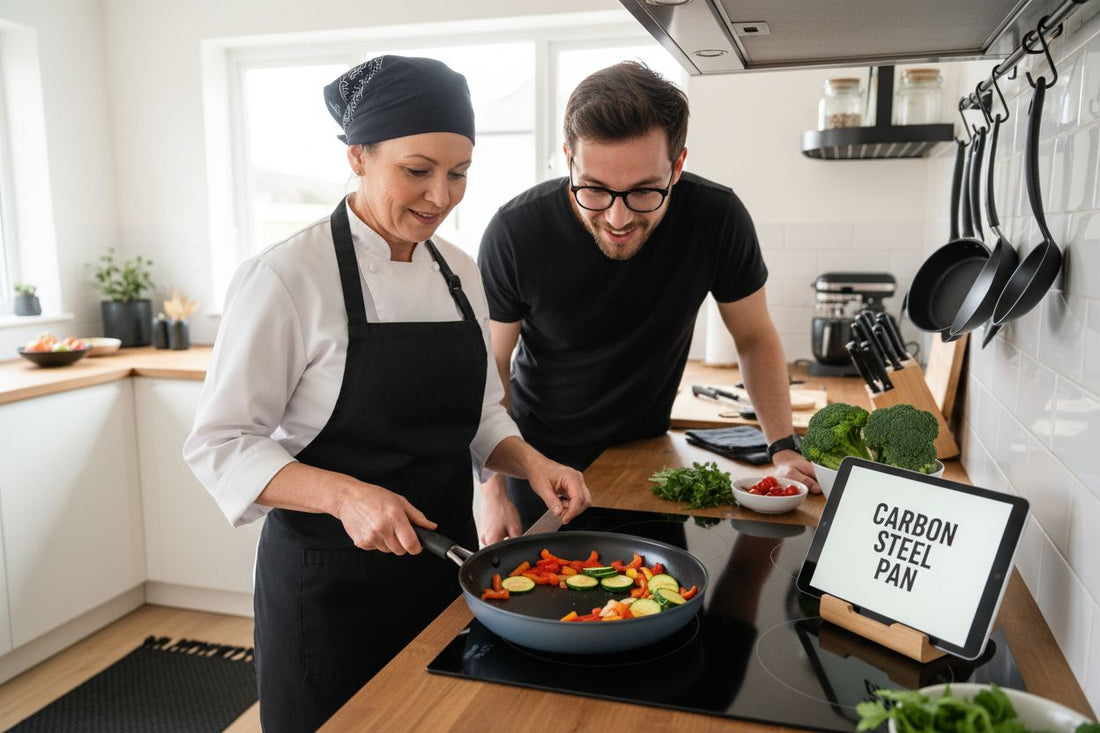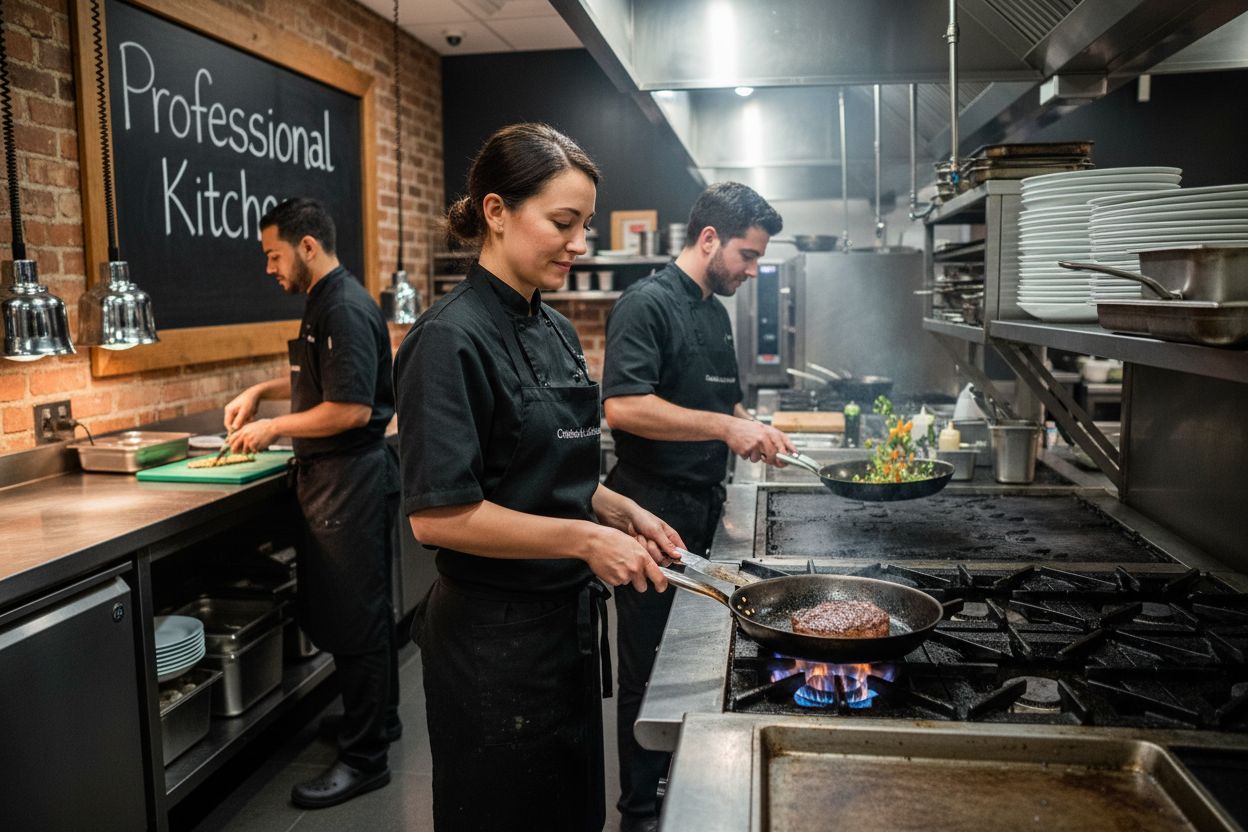
What is Carbon Steel Pan? Understanding Its Benefits and Uses
Share
Carbon steel quietly shapes some of the world’s finest cookware. Its unique composition features between 0.05% and 2.0% carbon, giving each pan a distinct balance between toughness and usability. Most people expect all metal pans to be heavy and hard to handle, but carbon steel defies this idea. It is both surprisingly lightweight and strong, winning over professional chefs and home cooks alike with its easy grip and resilient nature.
Table of Contents
- Understanding The Composition Of Carbon Steel
- Why Carbon Steel Pans Matter In Cooking
- How Carbon Steel Pans Work: Heat And Cooking Efficiency
- Key Features Of Carbon Steel Pans And Their Benefits
- Practical Applications In Professional And Home Kitchens
Quick Summary
| Takeaway | Explanation |
|---|---|
| Carbon steel pans heat quickly and evenly | Their thermal properties allow precise temperature control, ideal for various cooking techniques. |
| They develop a natural nonstick patina | Seasoning creates a protective layer that improves cooking performance over time. |
| Carbon steel allows versatile cooking methods | Suitable for stovetop, oven, and open flame, enhancing cooking flexibility. |
| They are durable and long-lasting investments | Robust construction withstands high temperatures and frequent usage, making them reliable. |
| Carbon steel is a healthier cooking choice | Free from synthetic coatings, it promotes safe cooking with rich flavour enhancement. |
Understanding the Composition of Carbon Steel
Carbon steel represents a sophisticated metal alloy with remarkable characteristics that make it crucial in cookware manufacturing. At its core, carbon steel is an iron based material featuring carbon as its primary alloying element, with carbon percentages typically ranging between 0.05% and 2.0%. Britannica defines carbon steel as a versatile metal that gains its unique properties through precise carbon content management.
The Chemical Composition
The fundamental structure of carbon steel revolves around two primary elements: iron and carbon. The carbon content dramatically influences the metal’s fundamental characteristics, determining its:
- Hardness
- Strength
- Malleability
- Durability
As carbon percentage increases, the steel becomes harder but potentially more brittle. Professional metallurgists carefully calibrate these percentages to achieve optimal performance for specific applications, including cookware manufacturing.
Performance Characteristics in Cookware
In culinary contexts, carbon steel demonstrates extraordinary heat conductivity and responsiveness. Its molecular structure allows rapid and even heat distribution, making it an exceptional material for professional and home cooking environments. Unlike other cookware materials, carbon steel develops a natural nonstick patina through seasoning, which enhances its cooking performance over time.
Interested cooking enthusiasts can read more about carbon steel health benefits to understand its comprehensive advantages beyond basic cooking performance.
The unique composition of carbon steel ensures it remains lightweight yet incredibly strong, capable of withstanding high temperatures and providing consistent cooking results. Its ability to develop a natural seasoning layer makes it a preferred choice among professional chefs and passionate home cooks seeking superior cookware that improves with age and use.
The following table breaks down essential features of carbon steel pans covered in the article, clarifying their specific benefits for cooks in both professional and home settings.
| Feature | Description | Benefit |
|---|---|---|
| Heat Conductivity | Rapid, even heat distribution | Enables precise, reliable cooking results |
| Natural Seasoning | Builds nonstick patina through regular use | Improves food release, enhances flavours |
| Lightweight Structure | Less heavy than comparable cookware materials | Easier to handle and manoeuvre |
| Durability | Withstands high temperatures, resists warping | Long-lasting investment |
| Versatile Cooking Methods | Suitable for stovetop, oven, and open flame | Expands available culinary techniques |
| Health and Sustainability | Free from synthetic coatings, improves with time | Safer, eco-friendly, and flavour enhancing |
Why Carbon Steel Pans Matter in Cooking
Carbon steel pans have emerged as a game changing culinary tool that bridges traditional cooking techniques with modern performance requirements. Professional chefs and home cooking enthusiasts increasingly recognise these versatile cookware pieces as essential kitchen investments that offer exceptional cooking experiences.
Superior Heat Management
Unlike other cookware materials, carbon steel provides extraordinary heat conductivity that allows precise temperature control. Culinary Institute research demonstrates that carbon steel heats rapidly and distributes temperature evenly, enabling chefs to achieve perfect searing, browning, and cooking results. The material’s remarkable responsiveness means:
- Faster heating compared to cast iron
- More uniform temperature distribution
- Quicker temperature adjustments
- Reduced risk of hot spots
Durability and Versatility
Carbon steel pans represent an investment in long lasting cookware. Their robust construction allows seamless transitions between stovetop and oven, making them incredibly versatile kitchen tools.
To help clarify the differences between popular cookware materials discussed, the following comparison table summarises key properties of carbon steel, cast iron, stainless steel, and aluminium for easy reference.
| Property | Carbon Steel | Cast Iron | Stainless Steel | Aluminium |
|---|---|---|---|---|
| Weight | Lightweight | Heavy | Moderate | Very lightweight |
| Heat Conductivity | Excellent | Good | Fair | Excellent |
| Heat Retention | High | Very high | Moderate | Low |
| Responsiveness to Heat | Very responsive | Slow | Fast | Very fast |
| Nonstick Potential | Develops natural patina | Develops natural patina | Requires coating | Requires coating |
| Oven/Flame Compatibility | Stovetop, oven, open flame | Stovetop, oven, open flame | Stovetop, oven | Stovetop, oven |
| Coatings Used | None (seasoned) | None (seasoned) | Sometimes (nonstick lines) | Often coated (nonstick) |
| Explore our comprehensive guide on cooking with carbon steel to understand their remarkable adaptability. |
Professional kitchens value carbon steel for its ability to withstand high temperatures and frequent usage.
Unlike fragile nonstick surfaces, these pans become more effective with consistent use, developing a natural seasoning that enhances cooking performance and creates a near nonstick surface.
Healthy Cooking Solution
Beyond performance, carbon steel represents a health conscious cooking choice. Free from synthetic coatings and potentially harmful chemicals found in traditional nonstick cookware, these pans offer a natural cooking surface that improves with each use. The gradual seasoning process creates a protective layer that enhances flavour profiles while maintaining the pan’s structural integrity.
Chefs appreciate carbon steel not just as a cooking tool, but as a culinary companion that grows and improves alongside their cooking skills.
How Carbon Steel Pans Work: Heat and Cooking Efficiency
Carbon steel pans represent a sophisticated cooking technology that transforms heat transfer and culinary performance. Their unique molecular structure enables exceptional cooking dynamics that distinguish them from conventional cookware materials.
Thermal Conductivity and Molecular Structure
Scientific research from Materials Engineering reveals that carbon steel’s molecular composition allows unprecedented heat responsiveness. The iron and carbon atoms create a lattice structure that enables rapid and uniform heat distribution. This means cooking temperatures become:
- Highly precise
- Quickly adjustable
- Consistent across the entire pan surface
- Responsive to cooking technique
Unlike aluminium or stainless steel, carbon steel’s thermal properties allow chefs to create perfect searing conditions within seconds, making it ideal for professional and home cooking environments.
Heat Retention and Energy Efficiency
Thermal mass plays a critical role in carbon steel pan performance. The material’s density enables it to absorb and retain heat more effectively than traditional cookware, reducing overall energy consumption. Master using carbon steel on induction cooktops to understand how these pans optimise cooking efficiency across different heat sources.
Professional chefs appreciate carbon steel’s ability to maintain stable temperatures, which is crucial for techniques requiring consistent heat like sautéing, searing, and reducing sauces. The pan’s thermal characteristics mean less energy is wasted, and cooking becomes more controlled and predictable.
Surface Interaction and Cooking Performance
Carbon steel’s surface transforms through a process called seasoning, creating a natural nonstick layer that enhances cooking performance. As oils polymerise during repeated use, the pan develops a protective patina that improves heat distribution and prevents food from sticking. This unique characteristic means the pan becomes more effective with each cooking session, unlike traditional nonstick surfaces that degrade over time.
The symbiotic relationship between pan and chef continues to evolve, making carbon steel not just a cooking tool, but a culinary instrument that responds and adapts to individual cooking styles.
Key Features of Carbon Steel Pans and Their Benefits
Carbon steel pans represent a pinnacle of culinary engineering, combining advanced material science with practical cooking performance. Understanding their distinctive features reveals why professional chefs and home cooking enthusiasts increasingly prefer these remarkable kitchen tools.
Structural and Material Advantages
Materials Science Research confirms that carbon steel’s unique composition delivers extraordinary performance characteristics. The pan’s fundamental structure provides:
- Exceptional durability
- Lightweight construction
- Superior heat responsiveness
- Natural nonstick capabilities
Unlike traditional cookware, carbon steel pans offer a remarkable balance between strength and flexibility.
![]() The molecular structure allows for rapid heat distribution while maintaining structural integrity across diverse cooking techniques.
The molecular structure allows for rapid heat distribution while maintaining structural integrity across diverse cooking techniques.
Performance and Versatility
Thermal adaptability distinguishes carbon steel from other cookware materials. These pans seamlessly transition between stovetop, oven, and even open flame, making them incredibly versatile cooking instruments. Is a carbon steel pan the right choice for you? Explore how these pans can transform your cooking experience.
Professional kitchens value carbon steel for its ability to withstand high temperatures and frequent use. The pan’s robust construction ensures consistent performance, developing a natural seasoning that enhances cooking results with each use. This unique characteristic means the cookware improves over time, unlike conventional nonstick surfaces that deteriorate.
Health and Sustainability Benefits
Carbon steel pans offer significant health advantages beyond traditional cookware. Free from synthetic coatings and potentially harmful chemicals, they provide a natural cooking surface that supports wholesome meal preparation. The gradual seasoning process creates a protective layer that not only prevents food from sticking but also enhances flavour profiles.
Moreover, these pans represent a sustainable cookware solution. Their longevity means reduced environmental waste, and their ability to last generations makes them an eco conscious choice for discerning cooks who value both performance and planetary responsibility.
Practical Applications in Professional and Home Kitchens
Carbon steel pans transcend traditional cookware limitations, offering remarkable versatility across diverse culinary environments. From bustling restaurant kitchens to intimate home cooking spaces, these exceptional pans deliver consistent, high performance cooking experiences.
Professional Kitchen Performance
Culinary Institute research confirms that carbon steel pans are indispensable tools for professional chefs. Their exceptional heat responsiveness and durability make them ideal for high intensity cooking scenarios. Professional kitchens value carbon steel for:
- Rapid temperature control
- Consistent searing capabilities
- Ability to withstand repeated intense use
- Seamless transition between cooking techniques
Restaurant chefs appreciate how these pans develop a natural seasoning that enhances flavour profiles, creating a symbiotic relationship between cookware and culinary craft.

Home Cooking Versatility
Adaptable cooking performance makes carbon steel pans perfect for home environments. Explore essential items for your professional kitchen cookware list to understand how these pans can elevate home cooking techniques. From delicate omelettes to robust meat searing, carbon steel provides home cooks unprecedented cooking flexibility.
Home cooking enthusiasts benefit from carbon steel’s ability to create restaurant quality results with minimal technical expertise. The pan’s forgiving nature allows both novice and experienced cooks to achieve consistent, delicious outcomes across various recipes and cooking styles.
Multi Functional Cooking Techniques
Carbon steel pans excel across multiple cooking methods, including stovetop sautéing, oven roasting, and even open flame cooking. Their robust construction allows seamless transitions between different heat sources, making them truly versatile kitchen instruments.
The pan’s remarkable heat retention and distribution capabilities mean home cooks can confidently prepare everything from delicate fish to hearty stews, knowing their carbon steel pan will deliver exceptional results every time. This versatility transforms cooking from a mere task to an enjoyable, creative experience.
Discover the Real Difference of Brass & Steel Carbon Steel Pans
Are you looking for cookware that truly elevates your home cooking or professional kitchen? After learning about the unique composition and benefits of carbon steel pans, many find themselves frustrated with ordinary pans that warp, underperform, or lose their nonstick finish. With a Brass & Steel carbon steel pan, you can achieve unmatched heat control, build up a natural nonstick seasoning, and enjoy heirloom-quality durability every time you cook. Browse the entire Carbon Steel Collection to see how our single-piece, PTFE-free pans solve common pain points like uneven heating and short-lived coatings.

Transform your cooking and invest in equipment trusted by culinary professionals. Visit https://brass-steel.com now to explore our best carbon steel pans, compare product sizes, and start creating your own seasoned pan that gets better with every meal. Take the next step towards better results and healthier meals today.
Frequently Asked Questions
What is a carbon steel pan?
A carbon steel pan is a cookware piece made from a combination of iron and carbon, known for its exceptional heat conductivity and responsiveness. It is lightweight, durable, and develops a natural nonstick surface through seasoning, making it popular among professional chefs and home cooks alike.
What are the benefits of using a carbon steel pan?
Carbon steel pans offer several benefits, including superior heat management for precise cooking, durability that withstands high temperatures, and a natural nonstick surface that improves with use. They also do not contain harmful synthetic coatings, making them a healthier choice for cooking.
How do you maintain a carbon steel pan?
Maintaining a carbon steel pan involves seasoning it regularly to build its nonstick patina, cleaning it without harsh chemicals, and drying it thoroughly to prevent rust. Proper care ensures the pan lasts for years and continues to deliver excellent cooking performance.
Can you use carbon steel pans on an induction cooktop?
Yes, carbon steel pans are compatible with induction cooktops as long as they have a flat base and magnetic properties. Their thermal conductivity allows for efficient heating on induction surfaces, making them suitable for various cooking techniques.